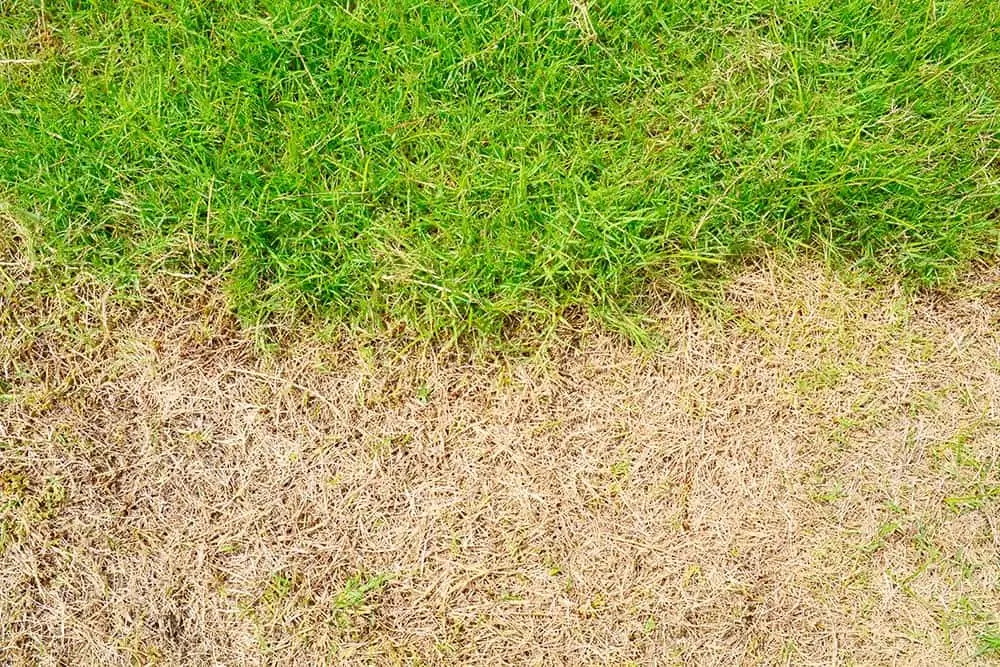There is nothing worse than having the grass on your lawn die and turn that awful brownish color. There are many reasons for which your grass might be brown and dying, but luckily, there is usually a way to revive your grass, depending on the cause for which it is going brown in the first place.
For most causes of brown grass, you can easily revive the lawn and bring it back to a healthy green color within a few weeks of proper care and maintenance. The most common cause of brown grass is the lack of watering, and the grass going dormant for a while, losing its healthy color.

So a few weeks of proper watering should do the trick! If you use special products and specific lawn fertilizers, they can help make the process a lot faster, and you could even start seeing signs of greener grass within a few days!
However, if your grass is brown because it is completely dead, then you won’t be able to bring it back at all. It’s a goner, and you will have to replant a new layer of grass and start all over again. Only this time, you’ll have hopefully learned the lesson, and will ensure the grass grows healthy and extra green!
Table of Contents
What does brown grass mean?
Brown grass is a clear sign that the grass isn’t absorbing any nutrients or water at the roots, and so the grass isn’t growing or thriving in a healthy manner.
This could be a sign that the grass is dying (or dead), which is bad, but it could also be a sign of the grass being dormant, which is a natural part of its life cycle.
Here are the two explained:
Dormant grass
Grass, just like some animals, has a hibernation period during the colder seasons. So during the end of the fall season, and all throughout winter, it is highly likely that your grass will turn a brownish color.
This means that it is dormant. It is hibernating through the winter, and it is a completely natural process, and to be expected every year.
Dying or dead grass
If your grass is turning brown during spring or summer, it is pretty clear that it isn’t down to it being dormant. Instead, it means your grass is not okay, and that something is wrong.
A brownish color means the grass isn’t absorbing the necessary nutrients and water, and it is usually down to it receiving improper care. If this is the case, you need to reassess and figure out what you’re doing wrong, and then put a remedy to it!
However, brown grass can also mean the grass is completely dead. In which case, there is nothing you can do.
If we look at the second meaning of grass being brown, the one in which it is dying or dead, it is usually down to improper care. So let’s take a look at some of the main things that can cause your grass to go brown, and how to fix them!
Incorrect watering
One of the main reasons for brown grass on your lawn is improper watering. As a general rule, you should be watering your grass once every week, providing it with about an inch of water each time you do so.
Frequent watering with low amounts of water should be avoided, as it weakens the roots, and it makes the grass more prone to becoming brown in the heat. So overwatering is usually the cause of grass going brown, just as much as not watering it enough.
To fix this, readjust your watering habits, and make sure your grass is getting just the right amount of water, only when needed!
Incorrect mowing
Some people obsessively mow their lawn, as they want it to constantly look picture-perfect, and as neat as possible. But mowing your grass too short can actually cause it to stress out, (exactly, over-mowing is stressing your grass out, so just chill), and that causes the grass to go dry and eventually turn brown.
As a general rule, your grass should be left at about 2 and a half or 3 inches long.
To stop it from getting stressed when you do mow it, get into the habit of mowing regularly, so that it never gets out of hand and you never have to over-mow it in one go!
An insect problem
If your lawn is infested with pests, they will be damaging the roots of the grass, causing it to go brown. This usually happens on lawns that aren’t cared for, but also on lawns that are over-pampered and over-fertilized.
To fix this, use a suitable pesticide, and then keep your lawn healthy to avoid future infestations.
Your pets
If you have a pet, and it’s relieving itself of its necessities on the grass, (aka, it’s peeing and pooping on your lawn), then that might be the cause of certain spots of grass going brown.
To fix this, teach your pets to go to the toilet in a specific place, and make sure to water the brown spots a little extra until they are back to a healthy green.
A fungus problem
If you find odd spots of brown, spread out around your lawn, this might be due to a fungus that has infected the grass. You will have to figure out what it is exactly, use the right product to get rid of it, and then nurse the grass back to health with some extra water.
Can brown grass turn green again?
If the brown grass isn’t completely dead, then yes! You can nurse the grass back to health by identifying the cause for it going brown, and taking the necessary steps. It will usually take around 3 weeks to get the grass back to full health, and then it’s all about maintenance!
Will watering dead grass bring it back?
Unfortunately, once the grass is dead, no amount of watering will be able to bring it back. You will have to re-seed the lawn, and re-grow new grass from scratch.

